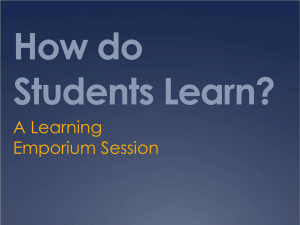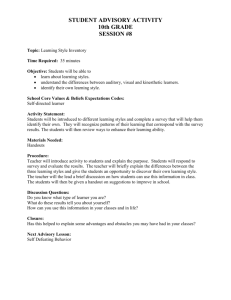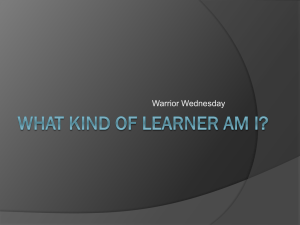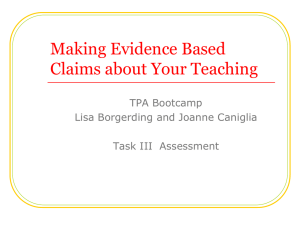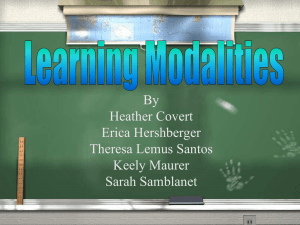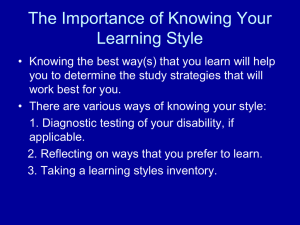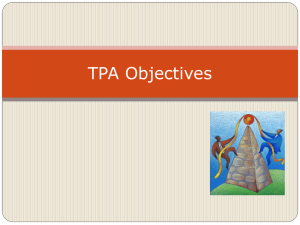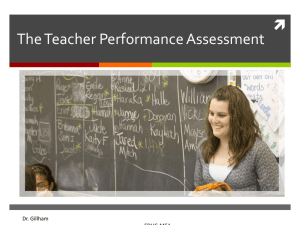Modifications for All Learners
advertisement
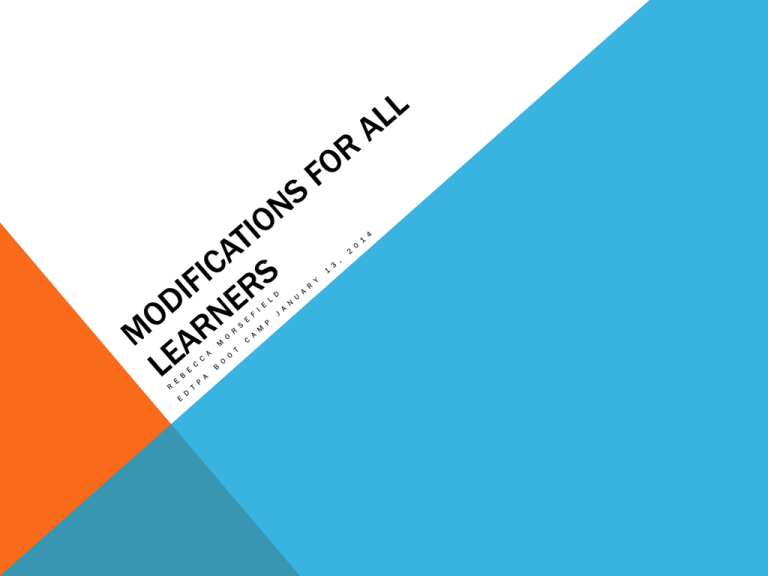
SUPPORTING ALL LEARNERS “Every student can learn, just not on the same day, or in the same way.” George Evans SUPPORTING ALL LEARNERS Objectives: 1. Explain why getting to know your students is the first step in the planning process. 2. Describe how knowing your students relates to differentiating instruction. 3. Identify strategies used to support all learners. TPA TASK 1 PLANNING FOR INSTRUCTION KNOWING YOU STUDENTS • What does the focus learner know? • What can he/she do? • What is he/she still learning to do? Why is this important? • In order to anticipate their learning needs and provide supports KNOWING YOUR STUDENTS I N F O R M AT I O N TPA VOC AB ULARY Strengths/weaknesses Interests/talents Prior learning experiences Relevant lived experiences Activities outside of school Family support/resources Community resources Cultural expectations Background knowledge for scaffolding new learning Personal, family, community, cultural assets WHERE CAN YOU OBTAIN INFORMATION ABOUT YOUR STUDENTS? • Interest Surveys • Learning Styles • District Data • Conferences • IEP’s or 504 Plans • Conversations • Writing Activities • Family • Observations • Student • Portfolios • Cooperating Teacher WHO ARE MY STUDENTS AND WHAT ARE THEIR REAL NEEDS • What do students need as learners? • What is valuable and relevant to your students? • What do they already know-past experience? “Make the TPA fit their needs….not the other way around! The more you know your students, the easier the TPA process becomes” TPA Tips (Kelly & Walters 2012) BE PROACTIVE-PLAN FOR DIFFERENCES • Without proper planning, it is difficult to succeed at meeting individual needs. • Remember “ONE SIZE DOES NOT FIT ALL” • Adjusting the curriculum by providing flexible options benefits all learners UNIVERSAL DESIGN FOR LEARNINGDIFFERENTIATION • Proactive planning framework • Based on the understanding that every classroom is composed of a variety of learning styles and abilities • Based on knowing the students (TPA) UNIVERSAL DESIGN FOR LEARNINGDIFFERENTIATION 1. Multiple Means of Representation Teacher uses a variety of strategies, tools and methods to represent information (visual, auditory, kinesthetic) 2. Multiple Means of Engagement Teacher provides a variety a ways to engage students (choice, address student interest, self- assessment and self-reflection) 3. Multiple Means of Expression Students use a variety of strategies, instructional tools and methods to demonstrate understanding CAST (www.cast.org) Universal design for learning resources BRUSH UP ON BLOOM’S TAXONOMY USE A VARIETY OF STRATEGIES & SUPPORTS Think-Pair-Share 1. How do you learn best? What type of learner are you? 2. Identify some of your favorite teaching strategies 2. Share with the person next to you http://www.youtube.com/watch?v=Dr_zh0_A MYA&feature=player_detailpage PLANNING LEARNING SEGMENT-THINK ABOUT • Prioritize-what am I really asking my students to do? • What does the student need to learn to progress Target Goal • What skills/abilities do you want them to develop? • Build learning segment around skills and abilities not activities and facts • What instructional strategies & learning tasks will you design? • Support individual students • Provide access to the curriculum QUESTIONS TO CONSIDER 1. Can student participate in the lesson as is, what supports might be needed? 2. How will I group students? (pairs, small group, cooperative groups) 3. What are the students learning styles (visual, auditory, kinesthetic, tactile)? 4. Will different materials be needed to ensure participation? 5. What might the student struggle with? 6. How can I modify instruction and support students? MAKE IT MEANINGFUL • How can you relate this information to past experience? • How can you make connections to future learning? • Why is this important? “Focus on opportunities to see, scaffold and showcase the process of your teaching.” TPA Tips (Kelly & Walters 2012) EFFECTIVE STRATEGIES • Specify clear lesson objectives • Teach directly to the objectives • Make learning as concrete and meaningful as possible • Provide time for practice and feedback • Model-note taking, metacognitive strategies, problem solving • Actively engage students-use a variety of instructional strategies • Scaffold instruction • Consider different learning styles (Visual, Auditory, Kinesthetic, Tactile) HOW DO YOU SCAFFOLD LEARNING • Model performance while thinking aloud • Pair advanced learners with developing ones • Provide prompts, links, guides and structure (Graphic Organizers) • Fade when appropriate I-WE-YOU • Tell me-direct instruction • Show me-guided practice • Let me-independent practice • Ask me-communicate, think aloud WHY USE GRAPHIC ORGANIZERS? • Classify ideas, link information • Structure thoughts for writing • Problem solving • Studying • Reviewing • Planning • Brainstorming STRATEGIES FOR STRUGGLING STUDENTS • Sequence-break down the task, step by step prompts. • Drill-repetition and practice review-daily testing of skills, repeated practice, daily feedback, • Segment-break down target skill into smaller units and then synthesize the parts into a whole. • Control the difficulty of the processing demands of the task-task is sequenced from easy to difficult and only necessary prompts or probes are provided • Technology-use a computer, structured text, flow charts, to facilitate presentation, emphasis on pictorial representations. • Group Instruction-Instruction occurs in small group • Strategy Clues-reminders to use strategies or multi-steps, the teacher verbalizes problem solving or procedures to solve, instruction uses think-aloud models. *Excerpted from Swanson, H.L. (1999). Learning Disabilities Research and Practice, 14(3). SUCCESSFUL TEACHERS • Provide a variety of opportunities for students to use knowledge and skills in different situations • Use Active Hands On student learning • Vary Instructional Practices and modes of teaching • Offer Real-World practical examples VISUAL, AUDITORY KINESTHETIC “Getting’ Triggy Wit It” www.watchknowlearn.org/Video.aspx?VideoID=32538 Check out Mr. Duey on Fractions! www.teachertubemrduey

